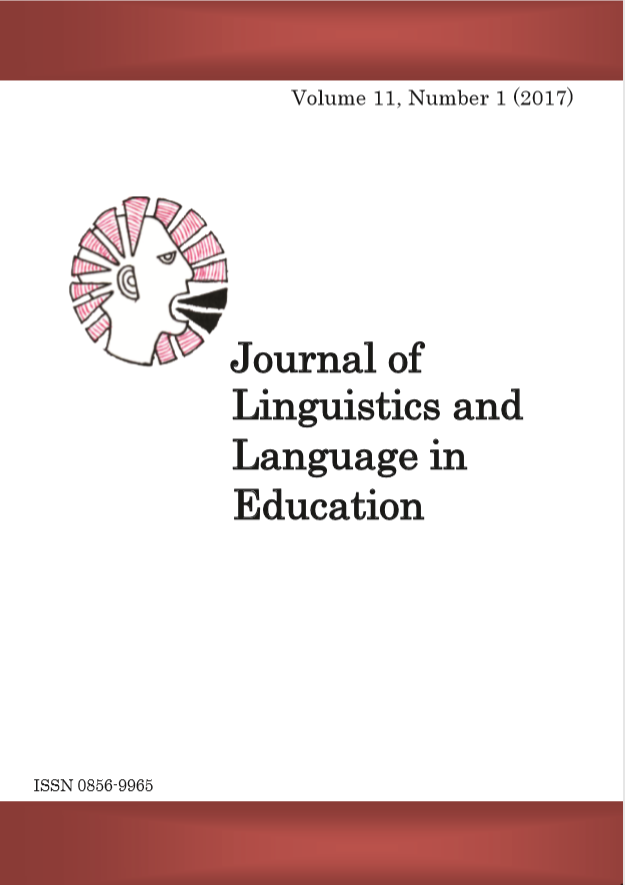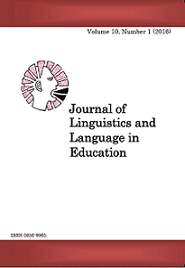The Morphosyntactic and Semantic Basis of Diminution and Augmentation in Shinyiha
Abstract
Among the strategies used to express diminution and augmentation in Bantu
languages is the use of particular prefixes in the Bantu Languages ' Noun Class
System. Being one of the Bantu languages, Shinyiha has its ways of forming
diminutives and augmentatives. Some of the ways coincide with those found in
other Bantu languages. Yet other ways are unique to Shinyiha. To explore how
diminution and augmentation processes are effected and their semantic basis
in Shinyiha is the concern of this paper. The paper offers a description and
discussion of diminution and augmentation in terms of what noun classes are
used as well as what the diminutives and augmentatives mean in Shinyiha. In
summary, the paper is concerned with the morphosyntactic and semantic basis
of the two processes i.e. how the processes are morphosyntactically and
semantically realized. Guérois, et al (2017) ' Parameters of Bantu
morphosyntactic variation ' are used to inform this paper, accounting for the
morphosyntactic aspects of the paper. To explain the semantic basis of
diminution and augmentation, Construal Operations proposed by Croft &
Cruse (2004) are used. The findings indicate that in Shinyiha diminution is
expressed by noun classes 7/8 and 12/13. On the other hand, augmentation is
expressed by noun classes 3/4 and 5/6. In each case different meanings are
expressed in addition to diminution and augmentation. It is concluded that
diminution and augmentation have semantic basis as they form part of human
communication strategies
References
Asheli, N. (2013). A Grammatical Sketch of Shinyiha. Dar es Salaam:
Languages of Tanzania Project (LOT) University of Dar es
Salaam.
Carstens, V. (1993). On Nominal Morphology and DP Structure. In S.
A. Mchombo (ed.) Theoretical Aspects of Bantu Grammar.
Stanford: Center for the Study of Language and Information:
€“180.
Croft, W. & Cruse, D. A. (2004). Cognitive Linguistics. Cambridge:
Cambridge University Press.
Crystal, D. (1997). The Cambridge Encyclopedia of Language (2nd
Edition). Cambridge: Cambridge University Press.
Frankl, P. J. L. (1994). Diminutives and Insignificance,
Augmentatives and ' monstrosity ' : Examples of Class Reassignment
in Swahili. In South African Journal of African
Languages, 14(3): 113 €“116.
Gibson, H., et al (2017). Patterns and Developments in the Marking
of Diminutives in Bantu. Nordic Journal of African Studies,
(4): 344 €“383.
Gibson, H., Guérois, R. & Marten, L. (2018). Dynamic Developments
in the Marking of Diminutives in Bantu. SOAS University of
London.
Guérois, R. et al. (2017). Parameters of Bantu Morphosyntactic
Variation: Draft Master List.
Hyman, L. & Katamba, F. X. (1993). The Augment in Luganda:
Syntax or Pragmatics? In S. A. Mchombo (ed.) Theoretical
Aspects of Bantu Grammar. Stanford: Center for the Study
of Language and Information: 151 €“180.
Kahigi, K. K. (2005). The Sisumbwa Noun: Its Classes and
Derivation. In Languages of Tanzania Project. Occasional
Papers in Linguistics 1. University of Dar es Salaam: 117 €“
Katamba, F. (2003). Bantu Nominal Morphology. In D. Nurse & G.
Philippson (eds.) The Bantu Languages. London: Routledge:
€“256.
Kishindo, P. (1998). Diminution, Augmentation and Pejorativeness
in lciNdali: The Semantics of Classes 5/6, 3/4, 7/8 and 21. J.
Humanlt. (Zomba), 12: 44 €“55.
Lindfors, A, Woodward, M, Nagler, L. & Krüger, S. (2009). A
Sociolinguistic Survey of the Nyiha and Nyika Language
Communities in Tanzania, Zambia and Malawi. SIL.
| The Morphosyntactic and Semantic Basis of Diminution and Augmentation
Maho, J. (2003). A Classification of the Bantu Languages: An Update
of Guthrie ' s Referential System. In D. Nurse & G. Philippson
(eds.) The Bantu Languages. London: Routledge: 639 €“651.
Maho, J. (1999). A Comparative Study of Bantu. Göteborg: Acta
Universitatis Gothoburgensis.
Matthews, P. H. (2007). The Concise Oxford Dictionary of Linguistics
(2nd Edition). Oxford: Oxford University Press.
Morshed, S. (2018). A Study of Augmentativization in English and
Bangla. Journal of ELT Research, 3: 68 €“77.
Mradi wa Lugha za Tanzania. (2009). Atlasi ya Lugha za Tanzania.
Dar es Salaam: Chuo Kikuu cha Dar es Salaam.
Ngunga, A. A. & Mpofu-Hamadziripi, N. (2013). A Study of Locatives
in Bantu: The Case of Shona and Yaawo. Journal of
Linguistics Association of Southern African Development
Community (SADC) Universities, 4: 44 €“55.
SIL International. (1988). Ethnologue: Languages of the World.
Dallas: Summer Institute of Linguistics.
Schadeberg, T. C. (2003). Derivation. In D. Nurse & G. Philippson
(eds.) The Bantu Languages. London: Routledge: 71 €“89
Downloads
Published
Issue
Section
License
Copyright © by Department of Foreign Languages and Linguistics, University of Dar es Salaam
All rights reserved. No part of this publication may be reproduced or transmitted in any form or by any means, electronic or mechanical, including photocopying, recording, or any information storage or retrieval system, without permission in writing from the publisher, except for short extracts in fair dealing, for research or private study, critical scholarly review or discourse with an acknowledgement.



